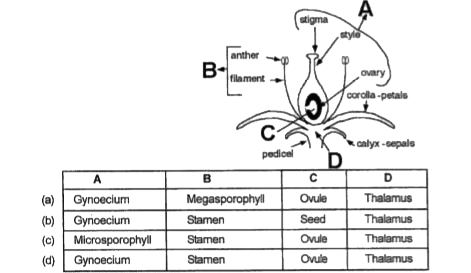The flask-shaped organ A at the centre of a flower is surrounded by a number of little stalks B having swollen tops which lie just inside the ring of petals.
Out of A and B, which one is (i) male part, and (il) female part of the flower ?
To answer the question about the parts of a flower, we can break it down step by step:
1. Identify Organ A: The question describes a "flask-shaped organ A at the center of a flower." This shape is characteristic of the carpel, which is the female reproductive part of the flower.
2. Identify Organ B: The question mentions "little stalks B having swollen tops." These swollen tops are indicative of the anthers, which are part of the stamen, the male reproductive part of the flower.
3. Determine the Roles:
- Organ A (Carpel): This is the female part of the flower. It contains the ovary, which produces female gametes (ova).
- Organ B (Stamen): This is the male part of the flower. It produces male gametes (pollen).
4. Conclusion:
- (i) The male part of the flower is B (the stamen).
- (ii) The female part of the flower is A (the carpel).
Final Answer:
- (i) Male part: B (Stamen)
- (ii) Female part: A (Carpel)
- Organ A (Carpel): This is the female part of the flower. It contains the ovary, which produces female gametes (ova).
- Organ B (Stamen): This is the male part of the flower. It produces male gametes (pollen).
- (i) The male part of the flower is B (the stamen).
- (ii) The female part of the flower is A (the carpel).
- (i) Male part: B (Stamen)
- (ii) Female part: A (Carpel)
Topper's Solved these Questions
- HOW DO ORGANISM REPRODUCEBOOK - BETOPPERSCHAPTER - HOW DO ORGANISM REPRODUCEEXERCISE - WORKSHEET 3
67 Videos
- HEREDITY & EVOLUTIONBOOK - BETOPPERSCHAPTER - HEREDITY & EVOLUTIONEXERCISE - COMPETITIVE WORKSHEET
34 Videos
- LIFE PROCESSESBOOK - BETOPPERSCHAPTER - LIFE PROCESSESEXERCISE - COMPETITIVE WORKSHEET
82 Videos
Similar Questions
The flask-shaped organ X at the centre of a flower is surrounded by a number of little stalks Y having swollen tops which lie just inside the ring of petals.
Name the organ Y.
View SolutionThe flask-shaped organ X at the centre of a flower is surrounded by a number of little stalks Y having swollen tops which lie just inside the ring of petals.
Name the organ X.
View Solution
Knowledge Check
Given below is the diagram of a typical flower. In which one of the options all the four parts A, B, C and D are correct?
 AaBbCcDd
AaBbCcDd
The dlask-shaped organ X at the centre of a flower is surrounded by a number of little stalks Y having swollen tops which lie just inside the ring of petals.
Out of X and Y, which one is the female part of flower ?
View SolutionThe dlask-shaped organ X at the centre of a flower is surrounded by a number of little stalks Y having swollen tops which lie just inside the ring of petals.
Which part of organ X contains gametes ?
View SolutionThe flask-shaped organ X at the centre of a flower is surrounded by a number of little stalks Y having swollen tops which lie just inside the ring of petals.
What does the swollen top of organ Y contain ?
View SolutionThe top part A of the flask-shaped reproductive organ X in the flower of a plant secretes a surgery substance into its lower part B which goes towards the bottom part C of the flask-shaped organ. When a tiny grain D coming from the top part E of another reproductive organ Y in the flower falls on part A, it grows a long tube F through the organ X in response to the sugary substance and reaches the bottom part C of flask-shaped organ to carry out fertilisation.
(a) What is (i) organ X, and (ii) organ, Y inside the flower?
(b) Name parts (i) A (ii) B, and (iii) C, of flask-shaped organ.
(c) Name (i) grain D, and (ii) part E of organ Y.
(d) Name the tube F.
(e) What is the phenomeon of growing a long tube in response to a sugary substance in the process of fertilisation in a flower known as?
View SolutionThe person A has only B chromosomes in all its gametes. On the other hand, another person C has chromosome D in half of gametes and chromosome E in the other half of gametes. When chromosomes B and D combine during fertilisation, a female zygote results. On the other hand, combination of B and E chromosomes produces a male zygote.
(a) What are chromosomes (i) B (ii) D, and (iii) E ?
(b) Out of B, D and E, which two chromosomes are of the same type ?
(c) Which chromosome is smaller in size ?
(d) What is the general name of chromosomes such as B and E ?
(e) Out of the two persons A and C, which one is (i) male, and (ii) female ?
View Solution(a) Write the names of those parts of a flower which serve the same function as the following do in the animals.
(i) testis, (ii) sperm,
(iii) ovary, (iv) egg
(b) State the function of flowers in the flowering plants.
View Solution(a) Write the names of those parts of a flower which serve the same function as the following do in the animals.
(i) testis, (ii) sperm,
(iii) ovary, (iv) egg
(b) State the function of flowers in the flowering plants.
View Solution
